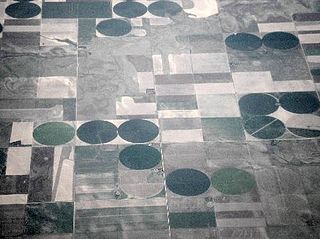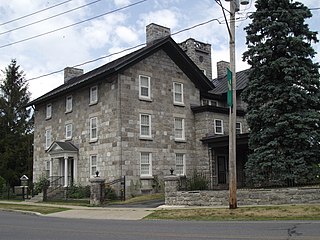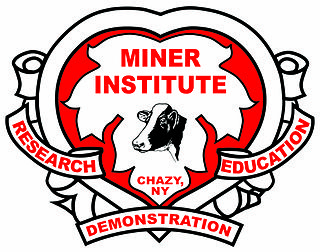Related Research Articles

A farm is an area of land that is devoted primarily to agricultural processes with the primary objective of producing food and other crops; it is the basic facility in food production. The name is used for specialized units such as arable farms, vegetable farms, fruit farms, dairy, pig, and poultry farms, and land used for the production of natural fiber, biofuel, and other commodities. It includes ranches, feedlots, orchards, plantations and estates, smallholdings, and hobby farms, and includes the farmhouse and agricultural buildings as well as the land. In modern times, the term has been extended so as to include such industrial operations as wind farms and fish farms, both of which can operate on land or at sea.

Agriculture is a major industry in the United States, which is a net exporter of food. As of the 2017 census of agriculture, there were 2.04 million farms, covering an area of 900 million acres (1,400,000 sq mi), an average of 441 acres per farm.

Agriculture in the Empire of Japan was an important component of the pre-war Japanese economy. Although Japan had only 16% of its land area under cultivation before the Pacific War, over 45% of households made a living from farming. Japanese cultivated land was mostly dedicated to rice, which accounted for 15% of world rice production in 1937.

Pastoral farming is aimed at producing livestock, rather than growing crops. Examples include dairy farming, raising beef cattle, and raising sheep for wool. In contrast, arable farming concentrates on crops rather than livestock. Finally, mixed farming incorporates livestock and crops on a single farm. Some mixed farmers grow crops purely as fodder for their livestock; some crop farmers grow fodder and sell it. In some cases pastoral farmers are known as graziers, and in some cases pastoralists. Pastoral farming is a non-nomadic form of pastoralism in which the livestock farmer has some form of ownership of the land used, giving the farmer more economic incentive to improve the land. Unlike other pastoral systems, pastoral farmers are sedentary and do not change locations in search of fresh resources. Rather, pastoral farmers adjust their pastures to fit the needs of their animals. Improvements include drainage, stock tanks, irrigation and sowing clover.

Avondale Agricultural Research Station or Avondale Discovery Farm is one of thirteen research farms and stations operated by Western Australia's Department of Agriculture and Food. In addition to its research, Avondale has historical buildings, a farming equipment museum and operates as an agriculture education centre specialising in introducing primary school children to farming, and teaching of its history in Western Australia.

The three University of Illinois round barns played a special role in the promotion and popularity of the American round barn. They are located in Urbana Township, on the border of the U.S. city of Urbana, Illinois and on the campus of the University of Illinois Urbana-Champaign. The University of Illinois was home to one of the Agricultural Experiment Stations, located at U.S. universities, which were at the heart of the promotion of the round barn. At least one round barn in Illinois was built specifically after its owner viewed the barns at the university. Though originally an experiment the three barns helped to lead the way for round barn construction throughout the Midwest, particularly in Illinois. The barns were listed as contributing properties to the U of I Experimental Dairy Farm Historic District, which was listed on the U.S. National Register of Historic Places in 1994.

The Camden Park Estate incorporating the Belgenny Farm is a heritage-listed large working historical farm located at Elizabeth Macarthur Avenue, in the south-western Sydney suburb of Camden South in the Camden Council local government area of New South Wales, Australia. It was designed by Henry Kitchen in c. 1800, John Verge in c. 1835 and A. J. Onslow in c. 1888 and built from 1819 to 1840 by John Macarthur in c. 1800, James English and Sons in c. 1888 and John Sulman c. 1895. The property is owned by Belgenny Farm Trust and Camden Park Preservation Committee. It was added to the New South Wales State Heritage Register on 22 December 2006. Today, part of the original estate contains the Elizabeth Macarthur Agricultural Institute; having originally served as a commercial sheep station and horticultural farm for the Macarthur family since the early 1800s.
Muscoot Farm is an early 20th-century interpretative farm museum in Katonah, New York in the United States. The farm is owned and operated by the Westchester County Department of Parks, Recreation and Conservation.

In New Zealand, agriculture is the largest sector of the tradable economy. The country exported NZ$46.4 billion worth of agricultural products in the 12 months to June 2019, 79.6% of the country's total exported goods. The agriculture, forestry and fisheries sector directly contributed $12.653 billion of the national GDP in the 12 months to September 2020, and employed 143,000 people, 5.9% of New Zealand's workforce, as of the 2018 census.
The economy of Saskatchewan has been associated with agriculture resulting in the moniker "Bread Basket of Canada" and Bread Basket of the World. According to the Government of Saskatchewan, approximately 95% of all items produced in Saskatchewan, depend on the basic resources available within the province. Various grains, livestock, oil and gas, potash, uranium, wood and their spin off industries fuel the economy.
Agriculture has historically been the primary industry of the English county of Cheshire. Dairy farming has predominated, and the county was particularly known for cheese-making.

The Alice T. Miner Museum, also known as Alice T. Miner Colonial Collection, is located at Chazy in Clinton County, New York on the Adirondack Coast. Opened in 1924, the museum was created by Alice T. Miner, a pioneer in the colonial revival movement and wife of William H. Miner, railroad industrialist.

The William H. Miner Agricultural Research Institute is a private, not-for-profit educational research institution with an operational dairy farm and Morgan horse herd located in Chazy, New York on the Adirondack Coast of Lake Champlain. Miner Institute currently encompasses over 8,600 acres of forest and agricultural land in the Little Chazy and Great Chazy river watersheds. The Institute is funded through an endowment, research grants and the sale of milk from its dairy operation.

Clover Forest, is a historic mansion, and former plantation house built starting in 1761 and located in Goochland, Virginia. The mansion lies in a large bend of the James River, and is an authentically restored in a Federal-style with portions of the architecture dating to Pre-American Revolutionary Period.

Scotland's Rural College (SRUC) is a public land based research institution focused on agriculture and life sciences. Its history stretches back to 1899 with the establishment of the West of Scotland Agricultural College and its current organisation came into being through a merger of smaller institutions.

Briarcliff Farms was a farm established in 1890 by Walter William Law in Briarcliff Manor, a village in Westchester County, New York. One of several enterprises established by Law at the turn of the 20th century, the farm was known for its milk, butter, and cream and also produced other dairy products, American Beauty roses, bottled water, and print media. At its height, the farm was one of the largest dairy operations in the Northeastern United States, operating about 8,000 acres (10 sq mi) with over 1,000 Jersey cattle. In 1907, the farm moved to Pine Plains in New York's Dutchess County, and it was purchased by New York banker Oakleigh Thorne in 1918, who developed it into an Aberdeen Angus cattle farm. After Thorne's death in 1948, the farm changed hands several times; in 1968 it became Stockbriar Farm, a beef feeding operation. Stockbriar sold the farmland to its current owners in 1979.
Ward Acres is a 62-acre park in the Wykagyl section of the city of New Rochelle, in Westchester County, New York. Formerly part of a large country estate and horse farm, New Rochelle purchased the land in 1962 with help from the New York State Park and Recreation Land Acquisition Bond Act.

Agriculture in Wales has in the past been a major part of the economy of Wales, a largely rural country that forms part of the United Kingdom. Wales is mountainous and has a mild, wet climate. This results in only a small proportion of the land area being suitable for arable cropping, but grass for the grazing of livestock is present in abundance. As a proportion of the national economy, the importance of agriculture has become much reduced; a high proportion of the population now live in the towns and cities in the south of the country and tourism has become an important form of income in the countryside and on the coast. Arable cropping is limited to the flatter parts and elsewhere dairying and livestock farming predominate.
Agriculture is a major component of the New York economy. As of the 2012 census of agriculture, there were over 35,000 farms covering an area of 7 million acres (28,000 km2) which contributed $5.4 billion in gross sales value and $1.2 billion in net farm income to the national economy. Dairy farming alone accounted for $2.5 billion or 45% of sales. The Finger Lakes region is the center of state agriculture, and the state is a top-ten national producer of cow milk, apples, grapes, onions, sweet corn, tomatoes, and maple syrup. New York places second in apples next to Washington.
References
- ↑ A North Country Legend William H. Miner: A North Country Legend, Retrieved October 30, 2011
- ↑ Miner Open House Open house shows interest in Miner Institute. July 28, 2009
- ↑ Life at Flat Rock. ‘’Life on the Rock’’ Westie, Leland. 2002. http://www.apnmag.com/natural%20selections/past%20stories/jack%20pine/jackpine.htm
- ↑ "WHMINER.COM". www.whminer.com. Retrieved 2016-05-10.
- ↑ Trailer to Heart's Delight: The Story of William H. Miner